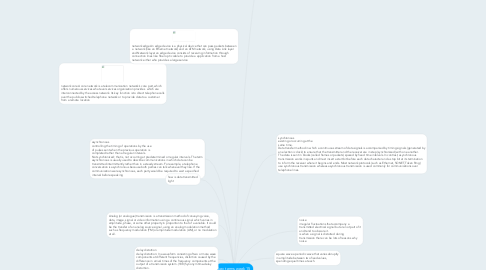key terms week 15
by Jeff my name is

1. An access network is the part of a telecommunications network which connects subscribers to their immediate service provider. It is contrasted with the core network, (for example the Network Switching Subsystem in GSM) which connects local providers to each other.
2. network core A core network is a telecommunication network's core part, which offers numerous services what ever services organisation provides which are interconnected by the access network. Its key function is to direct telephone calls over the public-switched telephone network or to provide data to a customer from a remote location
3. asynchronous controlling the timing of operations by the use of pulses sent when the previous operation is completed rather than at regular intervals. Not synchronized; that is, not occurring at predetermined or regular intervals. The term asynchronous is usually used to describe communications in which data can be transmitted intermittently rather than in a steady stream. For example, a telephone conversation is asynchronous because both parties can talk whenever they like. If the communication were synchronous, each party would be required to wait a specified interval before speaking
4. bandwidth a range of frequencies within a given band, in particular that used for transmitting a signal.
4.1. digital which means expressed as series of the digits 0 and 1, typically represented by values of a physical quantity such as voltage or magnetic polarization.
5. analogue a periodic wave that varies abruptly in amplitude between two fixed values, spending equal times at each.
6. attenuation Attenuation is the opposite of amplification, and is normal when a signal is sent from one point to another. If the signal attenuates too much, it becomes unintelligible, which is why most networks require repeaters at regular intervals. Attenuation is measured in decibels.
7. delay distortion delay distortion: In a waveform consisting of two or more wave components at different frequencies, distortion caused by the difference in arrival times of the frequency components at the output of a transmission system. (188) Synonym time-delay distortion.
8. Analog (or analogue) transmission is a transmission method of conveying voice, data, image, signal or video information using a continuous signal which varies in amplitude, phase, or some other property in proportion to that of a variable. It could be the transfer of an analog source signal, using an analog modulation method such as frequency modulation (FM) or amplitude modulation (AM), or no modulation at all.
9. how is data transmitted light
10. network edge An edge device is a physical device that can pass packets between a network (like an Ethernet network) and an ATM network, using Data Link layer and Network layer an edge device consists of receiving information through connection lines like fiber optic cable to provide a application from a host network either who provides a large service
11. noise irregular fluctuations that accompany a transmitted electrical signal but are not part of it and tend to obscure it. is when a signal is distorted during transmission there can be lots of reasons why noise
12. digital which means expressed as series of the digits 0 and 1, typically represented by values of a physical quantity such as voltage or magnetic polarization. square wave
13. transmission the action or process of transmitting something or the state of being transmitted
14. sine wave a curve representing periodic oscillations of constant amplitude as given by a sine function.
15. square wave a periodic wave that varies abruptly in amplitude between two fixed values, spending equal times at each.
16. synchronous existing or occurring at the same time. Data transfer method in which a continuous stream of data signals is accompanied by timing signals (generated by an electronic clock) to ensure that the transmitter and the receiver are in step (synchronized) with one another. The data is sent in blocks (called frames or packets) spaced by fixed time intervals. In contrast, asynchronous transmission works in spurts and must insert a start bit before each data character and a stop bit at its termination to inform the receiver where it begins and ends. Most network protocols (such as Ethernet, SONET, Token Ring) use synchronous transmission whereas asynchronous transmission is used commonly for communications over telephone lines.
17. network edge devices consoles An edge device is a type of networking device that connects an internal local area network (LAN) with an external wide area network (WAN) or the Internet. It provides inter connectivity and traffic translation between different networks on their entering edges or the network boundaries. console smart tv,s smart phones set top box pace makers smart watch tablets xbox live psn apple store netflix military weapons


